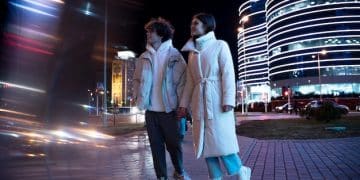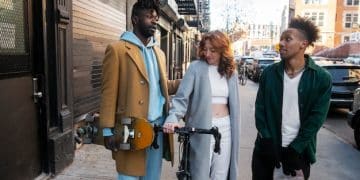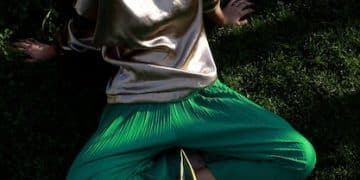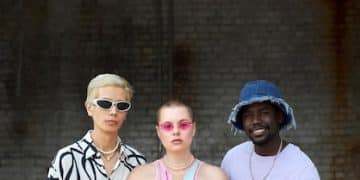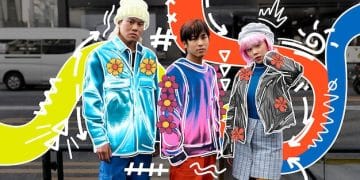Streetwear Color Trends 2025: Predicting Hottest Palettes
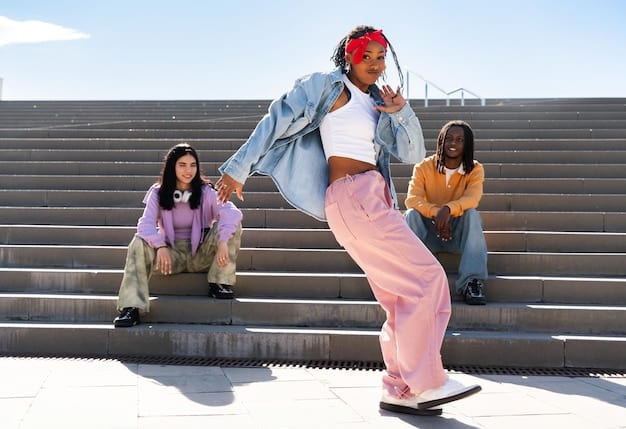
Predicting the hottest palettes for the 2025 streetwear season involves examining emerging cultural shifts, technological advancements, and sustainable practices that influence consumer preferences and fashion industry directions, culminating in a synthesis of bold and understated hues.
The streetwear landscape is a dynamic tapestry, constantly evolving and influencing mainstream fashion. As we look ahead, discerning the future of aesthetics requires more than guesswork; it demands a deep dive into social undercurrents, emerging technologies, and the ever-present drive towards sustainability. This exploration into Streetwear Color Trends: Predicting the Hottest Palettes for the 2025 Season aims to provide a comprehensive outlook, moving beyond superficial predictions to uncover the foundational impulses shaping tomorrow’s sought-after shades.
The Evolving Canvas: Understanding Streetwear’s Color Foundation
Streetwear’s relationship with color is complex and deeply rooted in its counter-cultural origins. Initially, early streetwear embraced utilitarian tones, a direct nod to workwear and military surplus. However, it quickly absorbed the vibrant energy of hip-hop, skate culture, and graffiti art, introducing a spectrum of audacious hues that challenged conventional fashion norms.
The essence of streetwear has always been about self-expression and rebellion, with color playing a pivotal role in signaling allegiance or individuality. From the primary pops of 90s sportswear to the muted, monochromatic palettes favoured by minimalist contemporary brands, each era has its distinct chromatic signature. As we approach 2025, a blend of past influences and forward-thinking sustainability is poised to redefine the “canvas.”
Historical Influences Shaping Current Trends
Examining the cyclical nature of fashion reveals that past trends often inform the future, albeit with contemporary twists. The resurgence of Y2K aesthetics, for example, has reintroduced bright, playful colors that were once ubiquitous. Similarly, the minimalist movement of the mid-2010s continues to exert influence, grounding many collections in more understated tones.
- 90s Nostalgia: Vibrant neons and bold primary colors, often seen in oversized fits.
- Early 2000s Pop: Iridescent finishes and pastel hues with a slight metallic sheen.
- Utility/Workwear: Earthy tones like olive green, khaki, and charcoal, reflecting durability.
- Skate Culture: A mix of faded brights and dark, durable basics.
These historical touchpoints aren’t merely replicated; they are reinterpreted through a modern lens, often incorporating new fabric technologies or sustainable dyes. The challenge for designers is to honor these influences while pushing the boundaries of innovation.
Sustainability and the Future of Dyes
A significant driver for 2025 color trends will undoubtedly be sustainability. Consumers are increasingly aware of the environmental impact of their clothing, pushing brands towards more eco-friendly practices. This has a direct bearing on color choice, favoring natural dyes, recycled materials, and production methods that minimize water and chemical usage.
Natural dyes, derived from plants, minerals, or even food waste, offer a more subdued and organic palette. While they may lack the intense vibrancy of synthetic dyes, their unique, earthy tones resonate with the growing demand for authenticity and environmental responsibility. Brands are investing in research and development to achieve brighter, more consistent results with these sustainable alternatives.
The commitment to reduced environmental footprint is not just a marketing ploy; it’s becoming an integral part of brand identity for streetwear labels. This shift will favor colors that can be achieved with less impact, driving innovation in textile engineering and dyeing processes.
Ultimately, the foundation of streetwear’s color palette in 2025 will be a thoughtful balance between historical resonance, contemporary flair, and an undeniable commitment to a more sustainable future. This evolving canvas is set to redefine what “cool” looks like.
Palette Predictions: Emerging Hues for 2025
Forecasting the exact shades that will dominate 2025 requires synthesizing various influences, from global cultural shifts to technological advancements in textile and dye production. Our predictions point towards a fascinating interplay of grounding, audacious, and subtly shifting palettes, reflecting a society grappling with global challenges while seeking expression and authenticity.
The Rise of “Techno-Organic” Earth Tones
As the line between the natural and digital blurs, we anticipate a new category of earth tones emerging. These aren’t just your standard greens and browns; they’re infused with a subtle, almost iridescent quality, hinting at technological enhancement or digital rendering. Think moss greens with metallic undertones, deep charcoals with a hint of purple, or sandy beiges that catch the light in unexpected ways.
- Digital Sage: A muted green with a cool, almost blue undertone, reminiscent of digital screens.
- Meta-Clay: A rich, warm brown infused with a subtle, almost ethereal glow.
- Urban Granite: A deep grey or charcoal with flecks of lighter tones, echoing cityscapes.
This trend speaks to a desire for grounding in nature, combined with an acknowledgment of our increasingly digital lives. Fabrics might feature subtle textures or treatments that enhance this dual nature, making these colors feel both timeless and futuristic.
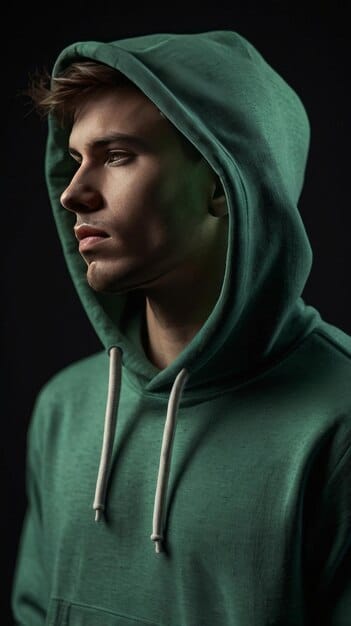
Vibrant Vistas: Audacious and Expressive Brights
While grounding tones will offer stability, streetwear will never truly abandon its love for bold, expressive colors. For 2025, we predict a resurgence of vibrant, almost electric brights, but with a nuanced approach. These won’t be the flat, primary colors of previous decades; they’ll have depth, perhaps even a slightly desaturated quality that makes them feel sophisticated rather than juvenile.
Imagine neon hues that have been “filtered” through a vintage lens, or brights that possess a subtle, lived-in feel. These colors will be used strategically, perhaps as accents against a more neutral base, or in striking two-tone combinations that create visual impact.
Examples might include “Hyper-Teal,” a deep, electric blue-green, “Solar Flare Orange” – a warm, almost glowing orange, and “Digital Lavender,” which has already begun to emerge, carrying a dreamlike quality. The audacious application of these colors on statement pieces like oversized jackets, cargo pants, or sneakers will continue to be a hallmark of streetwear’s individualistic spirit. The boldness is not just in the shade, but in the confidence it projects.
Subtlety and Sophistication: Blurring the Lines
Beyond the bold and the grounded, a quieter revolution will unfold in subtler palettes. These are the “new neutrals” – colors that defy easy categorization, sitting somewhere between traditional beige, grey, and soft pastels. They offer versatility and sophistication, allowing for endless layering and mixing, appealing to those who favor a more refined streetwear aesthetic.
Consider “Cloud Grey,” a pale, almost ethereal grey with a hint of blue, or “Misty Rose,” a dusty pink that avoids saccharine sweetness. These colors borrow from the worlds of luxury fashion and Scandinavian minimalism, integrating seamlessly into the streetwear rotation. They reflect a growing maturity in the streetwear market, where quality and understated elegance are increasingly valued.
These nuanced shades are perfect for building adaptable wardrobes, as they can be easily elevated with statement accessories or toned down for a more casual look. They represent a blending of comfort and chic, a key characteristic of contemporary streetwear, ensuring fluidity between different styles.
Cultural Currents: What’s Driving Color Choices?
The intersection of societal shifts, technological advancements, and a renewed focus on personal well-being are profoundly influencing the palettes consumers gravitate towards. Streetwear, as a barometer of youth culture and contemporary lifestyle, quickly absorbs these influences, translating them into wearable forms.
The Influence of Digital and Virtual Worlds
Our increasing immersion in digital and virtual spaces, from online gaming to the metaverse, is undeniably shaping visual preferences. The colors we encounter in these digital realms – often vibrant, glowing, and sometimes otherworldly – are bleeding into physical fashion. This manifests in iridescent fabrics, reflective materials, and colors that seem to shimmer with an internal light.
The “digital glow” is more than just neon; it’s a quality that suggests luminescence, akin to light emitted from a screen. This can be achieved through specific fabric treatments, layered materials, or even subtle graphic applications that mimic digital interfaces. Colors like electric blues, radiant purples, and even highly saturated greens gain popularity due to their prevalence in virtual environments. This phenomenon reflects a broader cultural acceptance and even celebration of digital aesthetics, translating them into tangible fashion statements.
Wellness, Mindfulness, and Nature’s Embrace
In contrast to the digital influence, there’s a strong counter-current driven by a global emphasis on wellness, mindfulness, and a return to nature. This movement inspires palettes rooted in organic tones, natural textures, and reassuring hues that evoke tranquility and balance. Streetwear brands, recognizing this desire for authenticity and comfort, are incorporating softer, more soothing colors into their lines.
Think of shades like earthy beiges, subdued greens, and calming blues, reflective of natural landscapes and a desire for peace amidst chaos. These colors are often paired with loose, comfortable fits and natural fibers, emphasizing a connection to simplicity and well-being. This trend isn’t about abandoning the urban aesthetic entirely, but rather about infusing it with elements of calm and groundedness, appealing to those who seek refuge from constant digital stimulation.
The colors might appear faded or washed, giving them a comforting, worn-in feel, as if they’ve been part of the natural world for some time. This subtle shift reflects a more conscious approach to consumption, where longevity and natural aesthetics often take precedence over fleeting trends.
Social Commentary and Activism
Streetwear has always been a medium for social commentary and activism. Color often plays a symbolic role in this, conveying messages of solidarity, rebellion, or hope. As societal issues continue to take center stage, we can expect colors to be chosen not just for aesthetic appeal, but for their inherent meaning.
This could translate into the strategic use of protest-associated colors (though these can vary greatly by context) or the embrace of natural, sustainable hues as a statement against fast fashion’s environmental impact. Brands may also support specific causes through color-coded collections, aligning themselves with movements for social justice or environmental protection. This is where color transcends mere aesthetics and becomes a powerful tool for visual communication, reinforcing streetwear’s role as both fashion and a cultural barometer.
For example, a vivid orange might represent optimism and energy, while a deep indigo could symbolize depth and introspection, echoing discussions around mental health and societal introspection. The intentionality behind color selection will grow, enhancing streetwear’s capacity to communicate nuanced social narratives.
Material Innovation and Color Expression
The symbiotic relationship between color and material is crucial in streetwear. New advancements in textile technology and dyeing processes aren’t just making production more sustainable; they’re also unlocking entirely new possibilities for how colors look, feel, and perform within garments. This pushes the boundaries of what a color can be, adding depth and experiential layers to the visual.
Smart Fabrics and Responsive Colors
Emerging smart fabrics are poised to revolutionize how we interact with color. Imagine garments that subtly shift hue based on temperature, light exposure, or even the wearer’s mood. While perhaps not widely commercialized by 2025, experimental applications of chromic dyes and responsive fibers could begin to appear in high-end or conceptual streetwear pieces, offering a glimpse into a future where color is dynamic and interactive.
Beyond radical shifts, smart fabrics can offer enhanced color retention, preventing fading, or introduce subtle functionalities like UV-reactive elements that change the perceived shade in different lighting conditions. This adds an element of surprise and playfulness, aligning perfectly with streetwear’s innovative spirit. These technological leaps are moving beyond merely durable fabrics to materials that actively participate in the aesthetic experience, making color a living component of the garment.
Recycled Materials and Their Unique Palettes
The increasing use of recycled materials, particularly recycled synthetics like RPET (recycled polyethylene terephthalate), presents both challenges and opportunities for color. While it’s becoming easier to produce a wide range of colors with recycled fibers, there’s often a subtle, inherent quality to these materials that influences the final shade. This can result in slightly muted, organic-feeling colors that perfectly complement the growing demand for sustainability.
Furthermore, textile recycling processes are advancing to reclaim and re-dye post-consumer garments, offering a closed-loop system for color. This often leads to unique, slightly desaturated tones that tell a story of their previous life. These “reclaimed” colors, rather than being seen as a limitation, are celebrated for their character and reduced environmental impact, aligning with the ethos of conscious consumption within streetwear.
Brands will increasingly experiment with blends of recycled materials, creating innovative textures and color variations that are inherently sustainable without compromising on style. This conscious choice of materials shapes the palettes, favoring hues that can be achieved with minimal resource expenditure.
Advanced Dyeing Techniques and Finishes
Beyond the fibers themselves, breakthroughs in dyeing techniques are expanding the chromatic horizon. Digital printing allows for intricate patterns and almost limitless color gradients, moving beyond traditional solid blocks. Meanwhile, advanced treatments can create fascinating surface effects, from matte finishes that absorb light to high-gloss treatments that reflect it, altering how a color is perceived. Pigment dyeing and garment dyeing processes continue to offer unique, washed-out looks, providing a lived-in feel from day one.
New forms of natural dyes, derived from increasingly diverse organic sources, are also gaining traction, offering a nuanced spectrum of earthy and muted tones. The emphasis shifts from simply applying color to carefully crafting an experience through the interplay of dye, material, and finish. These innovations mean that colors in 2025 streetwear will be richer, more complex, and more inherently tied to the material’s properties than ever before.
Regional Influences and Global Hybridization
Streetwear’s global reach means that no single region dictates trends entirely. Instead, a fascinating process of hybridization occurs, where local aesthetics are celebrated, absorbed, and reinterpreted across continents. This dynamic interplay will significantly diversify the color palettes we see in 2025.
East Asian Streetwear’s Impact
East Asian streetwear, particularly from cities like Tokyo and Seoul, has long been a major global influencer. Known for its avant-garde approach, meticulous attention to detail, and willingness to experiment with bold graphics and exaggerated silhouettes, it brings a distinct perspective to color. We anticipate a continued emphasis on crisp, clean lines paired with unexpected color combinations, often incorporating vibrant pastels, futuristic neons, and deep, saturated primary colors.
The use of contrasting elements – a sudden pop of bright against a muted base, or an intricate pattern in a kaleidoscope of hues – is characteristic of this region. Think of the structured vibrancy often seen in Japanese design, or the playful yet refined color integration in Korean fashion. These influences push global streetwear towards more experimental and highly curated color stories, encouraging the juxtaposition of unlikely shades.
European Streetwear’s Refinement
European streetwear often leans towards a more understated, sophisticated aesthetic, blending high fashion influences with urban grit. While still retaining a sense of individuality, the color palettes tend to be more refined, featuring rich, elegant tones, deep jewel colors, and a strong reliance on textural variations to add interest. The approach is often less about overt branding and more about quality materials and impeccable tailoring.
Expect to see deep navies, forest greens, rich burgundies, and elevated neutrals playing a significant role. These colors exude a quiet confidence and a sense of enduring style, appealing to a segment of the market that values longevity and subtle luxury. The European influence promotes the idea that streetwear can be both comfortable and chic, utilizing color as a tool for elevated expression rather than overt statement.
North American Trends and Influences
North American streetwear remains a powerhouse, especially with its deep roots in hip-hop, skate culture, and sports aesthetics. This region often dictates broader trends, mixing classic Americana with contemporary urban styles. Color palettes often reflect a bold, assertive stance, favoring strong primary colors, classic earth tones, and a willingness to integrate graphic-heavy designs with an immediate visual impact.
The influence of sports team colors, vintage collegiate aesthetics, and the enduring appeal of workwear continue to shape color preferences. While East Asia might lead in experimental future-forward palettes, and Europe in refined sophistication, North America often excels at making bold, accessible color statements that resonate with a wider audience, solidifying mainstream color trends. This blending of classic and contemporary, often expressed through oversized silhouettes and comfort-first design, is a hallmark of North American color trends, making them globally influential.
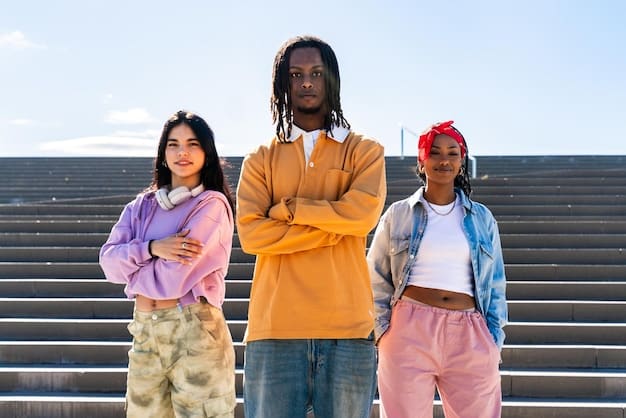
Psychology of Color: What Palettes Communicate
Colors are more than just aesthetic choices; they are powerful communicators, capable of evoking emotions, signaling intentions, and shaping perceptions. In streetwear, where self-expression is paramount, understanding the psychology behind the hottest palettes for 2025 is key to grasping their deeper cultural resonance.
Colors of Comfort and Security
In an increasingly uncertain world, there’s a strong psychological pull towards colors that evoke feelings of comfort, security, and nostalgia. This drives the popularity of soft, muted tones, warm neutrals, and organic shades that remind us of nature and simpler times. These colors offer a sense of grounding and reassurance, acting as a sartorial balm in chaotic times.
Think of soft creams, dusty blues, muted greens, and warm terracotta – colors that feel familiar and non-threatening. They communicate a desire for peace, stability, and authenticity. Opting for these hues in streetwear often signifies a preference for understated confidence and a rejection of overt flashiness, aligning with a more mindful and grounded approach to personal style. They create a calming aura around the wearer, inviting approachability and ease.
Colors of Optimism and Rebellion
Conversely, streetwear’s rebellious spirit thrives on colors that embody optimism, energy, and a defiant departure from the norm. Vibrant brights, electric neons, and unexpected color clashes fall into this category. These hues are chosen to make a statement, to stand out from the crowd, and to project a sense of confidence and forward-thinking attitude.
From energetic oranges and shocking pinks to dynamic yellows and electric blues, these colors communicate a refusal to be subtle. They’re about celebrating individuality, embracing creativity, and projecting a hopeful, even audacious, outlook on the future. The psychological effect is one of invigoration and attention-grabbing presence, reflecting a desire to challenge monotony and express a vibrant inner world. These colors often signal a youth subculture that is unafraid to be seen and heard.
Colors of Identity and Affiliation
Color is also a powerful tool for signaling identity and affiliation within streetwear subcultures. Certain colors, or combinations of colors, become synonymous with specific crews, aesthetics, or movements. This isn’t always about conscious branding; sometimes it’s an organic evolution within a community, where colors are adopted as unofficial uniforms or symbols of shared values.
For example, a preference for deep purples and blacks might align with a goth-inspired streetwear aesthetic, while bright greens and yellows could signify an eco-conscious or playful disposition. Brands that tap into these psychological connections often create deeper loyalty among their consumers, as the clothing becomes an extension of their personal and communal identity. The colors become visual shorthand, communicating belonging and shared ideology without needing words. This aspect of color psychology helps to define and solidify the ever-evolving tribes within the streetwear global community.
Conclusion
The 2025 streetwear season promises a rich and varied chromatic tapestry, reflecting the multifaceted influences shaping our world. From the grounding security of techno-organic earth tones to the rebellious energy of vibrant vistas and the quiet sophistication of new neutrals, the palettes will tell a complex story. Cultural currents, material innovations, regional aesthetics, and the timeless psychology of color all converge to define what’s next. As we move into 2025, streetwear’s visual language will continue to evolve, offering a compelling blend of tradition, innovation, and self-expression, inviting us to wear our narratives on our sleeves—literally.
| Key Color Trend | Brief Description |
|---|---|
| 🌍 Techno-Organic Earth Tones | Muted greens, charcoals, and beiges with subtle digital iridescence. |
| ⚡ Vibrant Vistas | Sophisticated, desaturated brights like Hyper-Teal and Solar Flare Orange. |
| ☁️ Subtlety & Sophistication | Elegant “new neutrals” such as Cloud Grey and Misty Rose. |
| ♻️ Sustainable Shades | Natural dyes and recycled material hues, emphasizing eco-consciousness. |
Frequently Asked Questions About 2025 Streetwear Color Trends
▼
“Techno-organic” earth tones are a predicted palette for 2025 that blend natural, grounding hues like greens, browns, and charcoals with subtle iridescent or metallic undertones. These colors reflect the merging of natural and digital aesthetics, offering a sophisticated yet futuristic feel to streetwear garments, symbolizing our increasingly intertwined physical and virtual realities.
▼
Sustainability will significantly influence 2025 streetwear color trends by favoring natural dyes, recycled materials, and eco-friendly production methods. This shift is driven by increased consumer awareness and brand commitment to environmental responsibility. Expect to see more subdued, organic-feeling colors derived from natural sources, along with innovations in dyeing processes that reduce environmental impact, leading to unique, character-rich hues.
▼
Both bright and muted tones will be highly relevant in 2025 streetwear, creating a balanced and dynamic aesthetic. While muted, sophisticated new neutrals and techno-organic earth tones provide a foundation for versatility and comfort, there will also be a strong presence of nuanced, desaturated brights like “Hyper-Teal” and “Solar Flare Orange.” These bold colors will be used strategically for expressive statements and striking combinations.
▼
Digital and virtual worlds significantly influence 2025 color trends by introducing colors with a “digital glow.” The prevalence of vibrant, glowing, and often otherworldly hues in online gaming and metaverse environments inspires physical fashion. This translates into iridescent fabrics, reflective materials, and colors that suggest inner luminescence, like electric blues and radiant purples, bridging the gap between digital aesthetics and physical garments.
▼
Regional influences create a dynamic hybridization of global streetwear color palettes for 2025. East Asian streetwear brings avant-garde, experimental combinations of vibrant pastels and futuristic neons. European streetwear favors refined, sophisticated deep jewel tones and elegant neutrals. North American trends contribute bold primaries and classic earth tones. This cross-cultural exchange ensures a diverse and ever-evolving range of color expressions.
Final Thoughts on Streetwear Color Forecasts
As we meticulously dissect the upcoming color narratives for 2025 streetwear, it becomes evident that the future is not monochromatic but rather a vibrant, complex blend of influences. From the deep psychological comfort offered by earthy tones to the undeniable audacity of reimagined brights, each hue is poised to tell a story. Understanding these predictions is not only about staying current but also about appreciating the intricate dance between global trends, personal expression, and the evolving conscience of the fashion industry. The palettes of 2025 will champion both individuality and collective consciousness, marking a significant evolution in streetwear’s chromatic journey.
